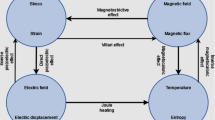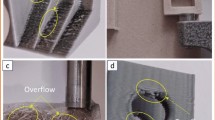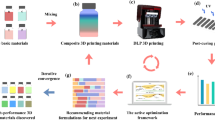Abstract
Fused filament fabrication (FFF) is one of the fastest-growing additive manufacturing processes due to its low operational cost and the capability to rapidly construct prototypes with complex geometrical structures. Albeit the fact that FFF technology has been widely studied, the printing conditions that offer the optimum mechanical behavior exploiting numerical tools have not been systematically studied yet. The main goal of the study is to introduce machine learning-based models that predict the tensile strength of 3D printed parts and the development of an optimization tool, which infers the appropriate printing conditions according to the requirements of the user. The current paper deals with a computational and experimental study over the effect of specific process-related parameters and their impact on the mechanical behavior of an object manufactured via the FFF procedure. The data for the development of the predictive models and the numerical optimization module were acquired by manufacturing specimens with varying printing conditions. The results demonstrate that by adapting the suggested values on the printing parameters from the machine learning models and the optimization module, a remarkable enhancement on the mechanical properties of the printed parts can be achieved. Finally, the present work is the first to utilize machine learning-based regression models coupled with optimization techniques in order to improve the mechanical behavior of products manufactured via the FFF process.





Similar content being viewed by others
References
I. Gibson, D.W. Rosen and B. Stucker, Additive Manufacturing Technologies, Springer, New York, 2010.
W.E. Frazier, Metal Additive Manufacturing: A Review, J. Mater. Eng. Perform., 2014, 23, p 1917–1928.
N. Kladovasilakis, K. Tsongas and D. Tzetzis, Finite Element Analysis of Orthopedic Hip Implant with Functionally Graded Bio-inspired Lattice Structures, Biomimetics, 2020, 5(3), p 44.
P. Charalampous, I. Kostavelis and D. Tzovaras, Non-Destructive Quality Control Methods in Additive Manufacturing: A Survey, Rapid Prototyp. J., 2020, 26(4), p 777–790.
P. Charalampous, I. Kostavelis, T. Kontodina and D. Tzovaras, Learning-Based Error Modeling in FDM 3D Printing Process, Rapid Prototyp. J., 2021, 27(3), p 507–517.
A. Dey and N. Yodo, A Systematic Survey of FDM Process Parameter Optimization and their Influence on Part Characteristics, J. Manuf. Mater. Process., 2019, 3(3), p 64.
E. Cuan-Urquizo, E. Barocio, V. Tejada-Ortigoza, R.B. Pipes, C.A. Rodriguez and A. Roman-Flores, Characterization of the Mechanical Properties of FFF Structures and Materials: A Review on the Experimental, Computational and Theoretical Approaches, J. Mater., 2019, 12(6), p 895.
O.A. Mohamed, S.H. Masood and J.L. Bhowmik, Optimization of Fused Deposition Modeling Process Parameters: a Review of Current Research and Future Prospects, J. Adv. Manuf., 2015, 3, p 42–53.
R.J. Zaldivar, D.B. Witkin, T. McLouth, D.N. Patel, K. Schmitt and J.P. Nokes, Influence of Processing and Orientation Print Effects on the Mechanical and Thermal Behavior of 3D-Printed ULTEM®9085 Material, J. Addit. Manuf., 2017, 13, p 71–80.
J. Cantrell, S. Rohde, D. Damiani, R. Gurnani, L. DiSandro, J. Anton, A. Young, A. Jerez, D. Steinbach, C. Kroese and P. Ifju, Experimental Characterization of the Mechanical Properties of 3D-Printed ABS and Polycarbonate Parts, Adv. Opt. Methods Exp. Mech., 2017, 3, p 89–105.
X. Deng, Z. Zeng, B. Peng, S. Yan and W. Ke, Mechanical Properties Optimization of Poly-Ether-Ether-Ketone Via Fused Deposition Modeling, J. Mater., 2018, 11(2), p 216.
B.M. Tymrak, M. Kreiger and J.M. Pearce, Mechanical Properties of Components Fabricated with Open-Source 3-D Printers Under Realistic Environmental Conditions, J. Mater. Des., 2014, 58, p 242–246.
M.M. Bazin, M.Z.M. Othman and M.M. Padzi, Optimization of 3D Printing Parameter for Improving Mechanical Strength of ABS Printed Parts, Int. J. Mech. Eng. Technol., 2019, 10(1), p 255–260.
S.U. Zhang, J. Han and H.W. Kang, Temperature-Dependent Mechanical Properties of ABS Parts Fabricated by Fused Deposition Modeling and Vapor Smoothing, Int. J. Precis. Eng. Manuf., 2017, 18, p 763–769.
H. Li, T. Wang, J. Sun and Z. Yu, The Effect of Process Parameters in Fused Deposition Modelling on Bonding Degree and Mechanical Properties, Rapid Prototyp. J., 2018, 24(1), p 80–92.
ASTM, Standard Terminology for Additive Manufacturing-Coordinate Systems and Test Methodologies, ISO/ASTM52921-13, ASTM International (2013)
M.F. Ashby, The Properties of Foams and Lattices, Philos. Trans. Royal Soc. A, 2016, 364, p 15–30.
M.S. Alsoufi, M.W. Alhazmi, D.K. Suker, T.A. Alghamdi, R.A. Sabbagh, M.A. Felemban and F.K. Bazuhair, Experimental Characterization of the Influence of Nozzle Temperature in FDM 3D Printed Pure PLA and Advanced PLA+, Am. J. Mech. Eng., 2019, 7, p 45–60.
M. Spoerk, F. Arbeiter, H. Cajner, J. Sapkota and C. Holzer, Parametric Optimization of Intra- and Inter-Layer Strengths in Parts Produced by Extrusion-Based Additive Manufacturing of Poly (lactic acid). J. Appl. Polym. Sci., 2017, 134(41)
M.K. Kim, I.H. Lee and H.C. Kim, Effect of Fabrication Parameters on Surface Roughness of FDM Parts, Int. J. Precis. Eng. Manuf., 2018, 19, p 137–142.
E. Vahabli and S. Rahmati, Application of an RBF Neural Network for FDM Parts’ Surface Roughness Prediction for Enhancing Surface Quality, Int. J. Precis. Eng. Manuf., 2016, 17, p 1589–1603.
T. Kotsiopoulos, L. Leontaris, N. Dimitriou et al., Deep Multi-Sensorial Data Analysis for Production Monitoring in Hard Metal Industry, Int. J. Adv. Manuf. Technol., 2021, 115, p 823–836.
ISO 527-1, Plastics -Determination of tensile properties -Part 1: General principles (2019)
W. Oliver and G. Pharr, An Improved Technique for Determining Hardness and Elastic Modulus Using Load and Displacement Sensing Indentation Experiments, J. Mater. Res., 1992, 7(6), p 1564–1583.
M. Mansour, K. Tsongas and D. Tzetzis, Measurement of the Mechanical and Dynamic Properties of 3D Printed Polylactic Acid Reinforced with Grapheme, J. Polym. Plast. Technol. Mater., 2019, 58(11), p 1234–1244.
M.E. Grigora, Z. Terzopoulou, K. Tsongas, P. Klonos, N. Kalafatakis, D. Bikiaris, A. Kyritsis and D. Tzetzis, Influence of Reactive Chain Extension on the Properties of 3D Printed Poly(Lactic Acid) Constructs, Polymers, 2021, 13(9), p 1381.
P. Charalampous, I. Kostavelis, C. Kopsacheilis and D. Tzovaras, Vision-Based Real-Time Monitoring of Extrusion Additive Manufacturing Processes for Automatic Manufacturing Error Detection, Int. J. Adv. Manuf. Technol., 2021, 115, p 3859–3872.
C.R. Siviour and J.L. Jordan, High Strain Rate Mechanics of Polymers: A Review, J. Dyn. Behav. Mater., 2016, 2, p 15–32.
F. Pedregosa, G. Varoquaux, A. Gramfort et al., Scikit-learn: Machine Learning in Python, J. Mach. Learn. Res., 2012, 12, p 2825–2830.
P.F. Smith, S. Ganesh and P. Liu, A Comparison of Random Forest Regression and Multiple Linear Regression for Prediction in Neuroscience, J. Neurosci. Methods, 2013, 220, p 85–91.
C. Hu, G. Jain, P. Zhang, C. Schmidt, P. Gomadam and T. Gorka, Data-Driven Method Based on Particle Swarm Optimization and k-Nearest Neighbor Regression for Estimating Capacity of Lithium-Ion Battery, Appl. Energy, 2014, 129, p 49–55.
M. Awad, R. Khanna, Support Vector Regression. In: Efficient Learning Machines. Apress, Berkeley, CA, 2015
M. Wauters and M. Vanhoucke, Support Vector Machine Regression for Project Control Forecasting, Autom. Constr., 2014, 47, p 92–106.
B. Akhoundi, M. Nabipour, F. Hajami and D. Shakoori, An Experimental Study of Nozzle Temperature and Heat Treatment (Annealing) Effects on Mechanical Properties of High-Temperature Polylactic Acid in Fused Deposition Modeling, Polym. Eng. Sci., 2020, 60, p 979–987.
P. Virtanen, R. Gommers, T.E. Oliphant et al., SciPy 1.0: Fundamental Algorithms for Scientific Computing in Python, Nat. Methods, 2020, 17, p 261–272.
R.E. Perez, P.W. Jansen and J.R.R.A. Martins, pyOpt: A Python-Based Object-Oriented Framework for Nonlinear Constrained Optimization, Struct. Multidis. Optim., 2012, 45, p 101–118.
L. Meng, B. McWilliams, W. Jarosinski et al., Machine Learning in Additive Manufacturing: A Review, The J. Min. Metals Mater. Soc., 2020, 72, p 2363–2377.
Acknowledgments
«This research has been co-financed by the European Union and Greek national funds through the Operational Program Competitiveness, Entrepreneurship and Innovation, under the call RESEARCH – CREATE – INNOVATE (project code: T1EDK- 04928)».
Author information
Authors and Affiliations
Corresponding author
Additional information
Publisher's Note
Springer Nature remains neutral with regard to jurisdictional claims in published maps and institutional affiliations.
Rights and permissions
About this article
Cite this article
Charalampous, P., Kladovasilakis, N., Kostavelis, I. et al. Machine Learning-Based Mechanical Behavior Optimization of 3D Print Constructs Manufactured Via the FFF Process. J. of Materi Eng and Perform 31, 4697–4706 (2022). https://doi.org/10.1007/s11665-021-06535-0
Received:
Revised:
Accepted:
Published:
Issue Date:
DOI: https://doi.org/10.1007/s11665-021-06535-0




